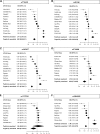Imputation and subset-based association analysis across different cancer types identifies multiple independent risk loci in the TERT-CLPTM1L region on chromosome 5p15.33
- PMID: 25027329
- PMCID: PMC4240198
- DOI: 10.1093/hmg/ddu363
Imputation and subset-based association analysis across different cancer types identifies multiple independent risk loci in the TERT-CLPTM1L region on chromosome 5p15.33
Abstract
Genome-wide association studies (GWAS) have mapped risk alleles for at least 10 distinct cancers to a small region of 63 000 bp on chromosome 5p15.33. This region harbors the TERT and CLPTM1L genes; the former encodes the catalytic subunit of telomerase reverse transcriptase and the latter may play a role in apoptosis. To investigate further the genetic architecture of common susceptibility alleles in this region, we conducted an agnostic subset-based meta-analysis (association analysis based on subsets) across six distinct cancers in 34 248 cases and 45 036 controls. Based on sequential conditional analysis, we identified as many as six independent risk loci marked by common single-nucleotide polymorphisms: five in the TERT gene (Region 1: rs7726159, P = 2.10 × 10(-39); Region 3: rs2853677, P = 3.30 × 10(-36) and PConditional = 2.36 × 10(-8); Region 4: rs2736098, P = 3.87 × 10(-12) and PConditional = 5.19 × 10(-6), Region 5: rs13172201, P = 0.041 and PConditional = 2.04 × 10(-6); and Region 6: rs10069690, P = 7.49 × 10(-15) and PConditional = 5.35 × 10(-7)) and one in the neighboring CLPTM1L gene (Region 2: rs451360; P = 1.90 × 10(-18) and PConditional = 7.06 × 10(-16)). Between three and five cancers mapped to each independent locus with both risk-enhancing and protective effects. Allele-specific effects on DNA methylation were seen for a subset of risk loci, indicating that methylation and subsequent effects on gene expression may contribute to the biology of risk variants on 5p15.33. Our results provide strong support for extensive pleiotropy across this region of 5p15.33, to an extent not previously observed in other cancer susceptibility loci.
Published by Oxford University Press 2014. This work is written by (a) US Government employee(s) and is in the public domain in the US.
Figures


References
Publication types
MeSH terms
Substances
Grants and funding
- P50 CA091846/CA/NCI NIH HHS/United States
- R01 CA092447/CA/NCI NIH HHS/United States
- P30 CA015083/CA/NCI NIH HHS/United States
- R01 CA154823/CA/NCI NIH HHS/United States
- U10 CA180899/CA/NCI NIH HHS/United States
- HHSN261200800001C/RC/CCR NIH HHS/United States
- UM1 CA182910/CA/NCI NIH HHS/United States
- 001/WHO_/World Health Organization/International
- HHSN261200800001E/CA/NCI NIH HHS/United States
- R01 CA057494/CA/NCI NIH HHS/United States
- 16491/CRUK_/Cancer Research UK/United Kingdom
- P30 CA015704/CA/NCI NIH HHS/United States
- P50 CA062924/CA/NCI NIH HHS/United States
- G1000143/MRC_/Medical Research Council/United Kingdom
- UM1 CA173640/CA/NCI NIH HHS/United States
- K07 CA172294/CA/NCI NIH HHS/United States
- P50 CA102701/CA/NCI NIH HHS/United States
- 14136/CRUK_/Cancer Research UK/United Kingdom
- P50 CA097257/CA/NCI NIH HHS/United States
- G0401527/MRC_/Medical Research Council/United Kingdom
- R01 CA052689/CA/NCI NIH HHS/United States
- UM1 CA182876/CA/NCI NIH HHS/United States
LinkOut - more resources
Full Text Sources
Other Literature Sources
Molecular Biology Databases

